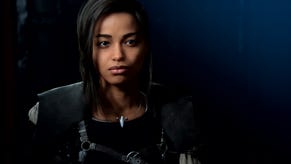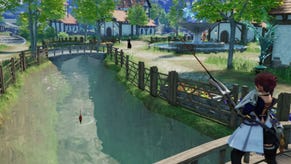Forspoken revisited on PS5: does the final update fix the game's technical issues?
And is the game worth playing now versus Final Fantasy 16?
Forspoken was one of the most promising early PS5 showings, revealed with death-defying parkour, wide-open landscapes and beautiful visuals throughout. At launch, the game was far less impressive though - a repetitive, empty game with surprisingly dated graphics despite its high budget. A dedicated patching campaign seems to have improved the title's plight, with reported visual and performance improvements in tow as of version 1.2. Have recent patches turned Forspoken into a technically sound title, or does the game remain a bit of an open-world mess? Some might say it's both of these things, but let's be clear - improved lighting, dramatically better ambient occlusion, higher resolutions and even superior frame-rates represents an often night-and-day improvement over the original launch.
Getting into specifics, let's start with performance and resolution changes, before diving into more transformative upgrades to the game's indirect lighting. As a reminder, some areas of the launch version of Forspoken had serious performance issues, often dipping to around 20fps in both quality and RT modes despite a 30fps target. Meanwhile, performance mode exhibited frequent frame-rate dips in combat, souring the experience.
The good news is that these issues appear to have been solved in 1.2, with a steady 30fps in quality and RT modes and 60fps during the vast majority of combat. Forspoken also includes 120Hz versions of each of its three modes, with quality and RT targeting 40fps while performance mode remains at 60fps and these modes also perform well, essentially trading resolution for higher or more stable performance. There are still occasional dips, but the vast majority of the performance issues seem to have been resolved which makes the game feel a lot better to play.
Interestingly, when comparing the game's dynamic resolution system between 1.0 and 1.2, I noticed that the more recent code often exhibits higher internal resolutions than 1.0 in the 60Hz quality and performance modes, despite their improved performance - perhaps due to changes with the game's lighting and fog in the most recent version.
After all, the biggest issue with Forspoken's visual presentation was its relatively poor indirect lighting. When we light spaces in video games, we need to be mindful of the way that light propagates through real-world environments, bouncing and scattering around physical objects, flooding areas with reflected luminance, with subtle occlusion when it is impeded. In games, we usually model these phenomena through global illumination (GI) and ambient occlusion (AO) techniques. Approximating these secondary effects of light was a key technical advancement in last-gen games, with most adopting baked GI and screen-space ambient occlusion (SSAO) alongside the use of physically-based materials.
Forspoken had poor secondary lighting though, seeming to rely on basic, low-fidelity baked GI solution with ambient occlusion that consisted only of simple dark outlines where geometry intersected. A lot of materials ended up looking shiny, with very visible specularity, so they appeared reflective even when their real-world counterparts had diffuse surfaces. As a result, Forspoken - despite decent-looking characters and fairly detailed models - just didn't look right in a lot of lighting conditions. Thankfully, this is the key area where the new patches have delivered very substantial improvements.

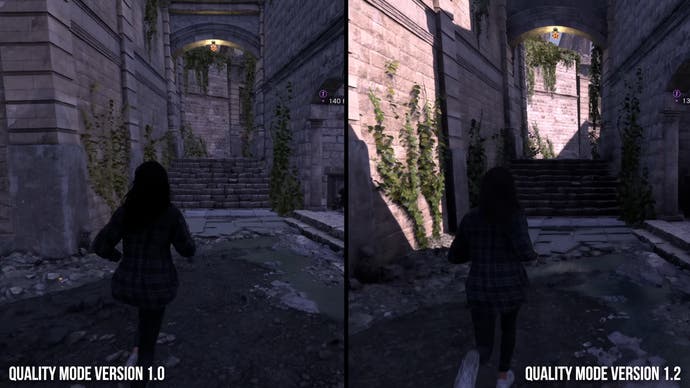
As of version 1.2, Forspoken's ambient occlusion has been overhauled. Gone is the crude-looking AMD CACAO implementation that was present before, replaced with a better-looking alternative. Deep crevices are filled convincingly with shade, while geometric intersections only receive noticeable AO coverage when appropriate. This more subtle shading and more realistic lighting overall is transformative in many scenes, like the courthouse in the opening cutscene. With the prior AO solution, this shot had a very "seventh-gen" appearance, but the new AO is doing an enormous amount of work to make this scene look properly lit.
That's not to say that the new AO is a complete improvement in every respect. In some spots it can look a bit heavy-handed, darkening areas more than seems realistic. You do get the sense that Forspoken is relying quite heavily on SSAO to handle its secondary lighting, which looks fine most of the time in the updated version of the game but can produce odd results at times. AO coverage also tends to be a bit thick around foliage - appropriate enough in dense patches of grass, but around more sparse grass placements it seems excessive. The AO also tends to throw up quite a bit of aliasing in the game's performance mode, most notably on foliage - the RT and quality modes mostly resolve without noise but in the performance mode it can be distracting.
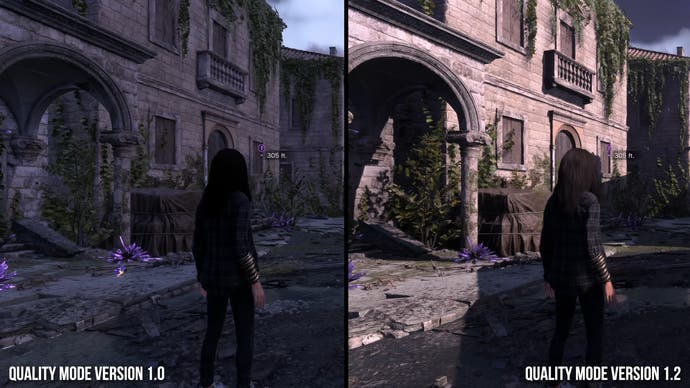
That's not the only lighting change at hand. In some areas, light intensity seems to have been adjusted, while fog has been stripped back in comparison to the launch version of the game. This is probably good for gameplay purposes, but it doesn't especially flatter distant detail, which was often occluded by the fog before. Frey's hair also appears quite different in the updated version, with a bit of a grey cast in most scenes, depending on lighting conditions. I'm not sure whether to score this as an upgrade or a downgrade, but I do think it can appear unnatural sometimes in indirect lighting. To Forspoken's credit, hair does animate very nicely during both cutscenes and gameplay, with a very dynamic presentation we don't often see in games.
Outside of those changes, the rest of Forspoken's lighting remains the same - so the baked lighting can still appear crude with insufficient detail, materials can still look too shiny and distant objects still lack shadow coverage regardless of RT being engaged. Reflections are also a weak point, with some water surfaces not matching the environment at all even with necessary screen space information in view. Other times, even when SSR coverage is decent, the reflections aren't distorted in line with the normal-mapped ripples on the water itself. Other issues John noted in his original coverage on the game also remain, including odd environmental modeling decisions and obvious texture tiling.
Despite those caveats, Forspoken now looks closer to what you'd expect from a current-gen game. The most obvious lighting flaw has been addressed, leaving the game on much firmer graphical footing. It's not exactly impressive, but it feels more competent relative to what we saw back in January. This is how Forspoken should have been configured at launch.
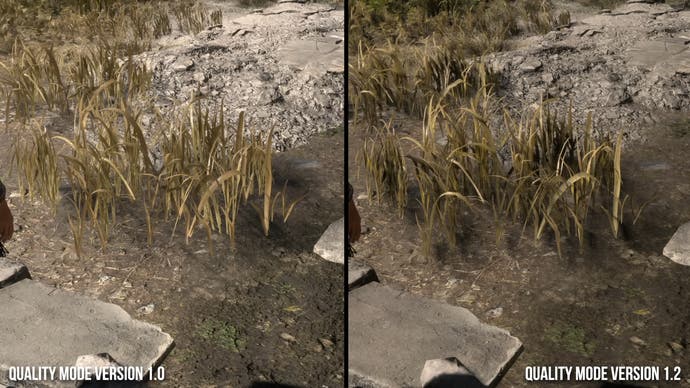
In a lot of ways, Forspoken was a failure. It reviewed poorly, sold fewer copies than expected, and the studio responsible for its development has now been disbanded. From a visual perspective, it still doesn't look great either, despite being based on the Luminous Engine - which has powered some very attractive demos as well as Final Fantasy 15. Meanwhile, the recently released Final Fantasy 16 has proved very much the opposite, being well-received by press and public alike and with an impressive visual makeup despite being based on internal technology that hasn't been disclosed. These are two big-budget Square-Enix action RPGs released within six months of each other, but graphically they're worlds apart.
Character rendering in Forspoken is fine enough, but FF16 is a big step ahead. Materials look much better here, with very pleasing differentiation between the different fabrics, leather, and metals on character models. Forspoken is a bit more one-note by comparison - most clothing materials tend to look a bit on the shiny side, making fabrics look strange. Character faces look mostly fine, but can fall apart in close-ups and sometimes animate oddly as well, with FF16 faring much better in comparison.
The revised lighting in Forspoken still has obvious flaws. The AO has its issues, often appearing very strong and is subject to occlusion problems when moving the game camera. Light leak is a near-constant annoyance in enclosed spaces, with the baked lighting obviously at a low resolution. Distant geometry is bereft of any shadow coverage whatsoever. The shadows that do appear aren't great, suffering from hard aliased edges using rasterised shadows and distracting pop-in when the RT setting is enabled.

FF16 mostly avoids those flaws. The baked lighting looks excellent, ambient occlusion is applied in a tasteful and restrained manner, and shadow rendering is much superior. It's not clear exactly what techniques are being used for the shadows here, but they exhibit realistic variable penumbra and don't suffer from obvious pop-in, and tend to look a lot better than the RT solution present in Forspoken.
The action combat in Forspoken can be very pretty at times, but it has a tendency to feel disconnected from player input. It's often not clear what will happen when the player hits the circle button, for instance, which triggers the game's acrobatic parkour moves. At times it can feel like the game is sort of playing itself. FF16 has a less context-sensitive range of moves and takes a more grounded approach to player locomotion, and feels a lot better on a gamepad as a result. Plus, the latest Final Fantasy still has visually exciting combat maneuvers, especially during the game's pulse-pounding boss encounters.
I don't bring any of this up to harp on Forspoken's flaws, but it is odd that Square-Enix has effectively produced two different big action RPG titles with such different visual and gameplay outcomes in the first half of this year. Forspoken certainly didn't achieve the graphical benchmarks Luminous Productions set out for the title with early trailers, or even with their presentations to other game developers. Perhaps a more unified approach to engine development would have paid dividends here, or at least greater technology transfer within Square-Enix for key techniques. And there are some things that Forspoken has to offer as well - like its excellent Luminous Hair system.
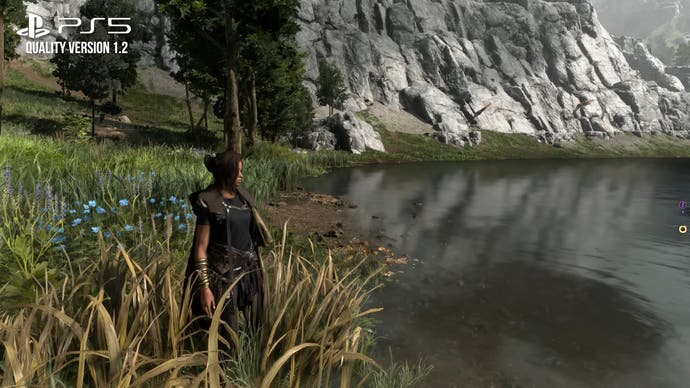

In any case, I'm certainly hoping the engine tech used for Final Fantasy 16 continues to be developed and used for future Square-Enix efforts. And while it's always sad to lose a proprietary engine, I can't help but feel glad that the Luminous Engine is being dropped, as the visual results fall below expectations - even with the latest updates.
It does seem like we've seen the last of Forspoken too, for better or for worse. The game's development studio was shuttered on May 1st, with the game's sole DLC expansion and most recent patch arriving shortly thereafter. Final Fantasy 15 was improved and expanded dramatically through a pretty tremendous post-release patching and content release effort, but Forspoken doesn't seem to be enjoying the same treatment.
So, in its final state, Forspoken is a more attractive, more performant version of the title we saw in January - but the game still suffers from major graphical flaws, gameplay issues, and a empty open world environment. For those interested though, the visual and performance boosts make Forspoken a substantially more enjoyable title than it was at launch.
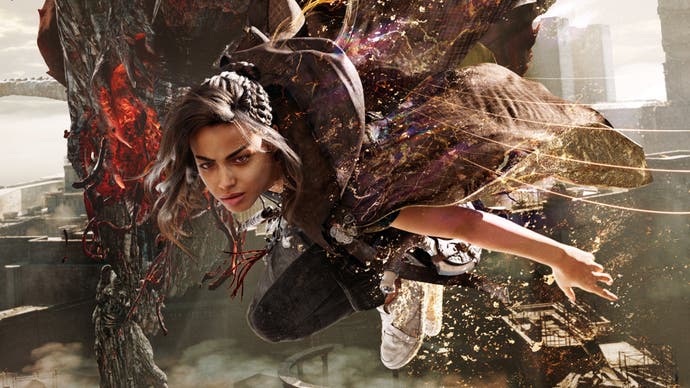




.png?width=291&height=164&fit=crop&quality=80&format=jpg&auto=webp)

